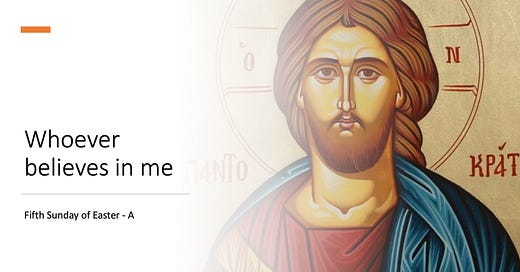Acts 6:1-7; 1 Peter 2:4-9; John 14:1-12
"Let not your hearts be troubled" (John 14:1). Jesus' words about going away where they could not follow him made his disciples anxious (John 13:33; 35). What about them? Aware of their feelings, Jesus calls them to believe in God and in him (John 14:1), and then patiently answers their question and request (John 14:5,8).
"Lord, we do not know where you are going. How can we know the way? (John 14:5). "I am the way." The metaphor of the way refers to the whole life of Christ at the center of which is the mystery of the cross and resurrection. Jesus through the cross went to the Father. Therefore, anyone who wants to come to the Father needs to take up his cross and follow him (Matt. 16:24). "I am the truth." Jesus reveals that God is love (1 John 4:8) and that human beings are destined to "become partakers of the divine nature" (2 Pet. 1:4). "I am the life." Many are fascinated by the longevity of people who lived before the Flood (Gen. 5:1-31). But what is a thousand years of captivity in sin compared to eternity in the Father's house (John 14:2)?
In the first reading, we hear that many priests "became obedient to the faith" (Acts 6:7). They realized that although the law of Moses could lead them to Christ (Gal. 3:24), only Christ leads to the Father. As there is no other name in which humanity can be saved except the name of Jesus (Acts 4:12), so also "no one comes to the Father except through" Jesus (John 14:6). By God's sovereign decision Jesus is that "chosen and precious cornerstone" from the prophecy of Isaiah (Is. 28:16) and those who believe in him shall never be put to shame (1 Pet. 2:6).
"Show us the Father and it is enough for us" (John 14: 8). Jesus did not come to show the Father; he came to reveal the Father (John 1:18). One can show a sign (John 2:18), future events (Matt. 16:21), the path of love (1 Cor. 12:31), or the reality of heaven (Rev. 22:8). "To reveal", however, means to narrate one's own experience (Luke 24:35). Yet, since "no one has ever seen God" (John 1:18) and "no one knows the Father except the Son" (Matt. 11:27), so only the Son has made [the Father] known (John 1:18).
"Have I been with you so long, and you still do not know me, Philip? Whoever has seen me has seen the Father"(John 14:9). The process of knowing begins with an invitation, "come and see" (John 1:39), and leads to the realization that Jesus is the icon of the invisible God (Col 1:15). But not all who see Jesus come to this realization. The crowds who followed him out of curiosity, the Pharisees and scribes who opposed him, or Pilate who sentenced him to death, all saw Jesus and yet they did not see the Father. It is not enough to see Jesus through our physical eyes, one must look at him through the eyes of faith. “Unless you believe, you will not understand” (Is. 7:9, LXX).
The number of disciples was increasing, many priests embraced the faith, and among those on whom the apostles laid their hands were Stephen and Philip (Acts 6:5). Stephen "was working great wonders and signs among the people" in Jerusalem (Acts 6:8), Philip preached the Gospel in Samaria performing great miracles as well (Acts 8:4-8), and the spiritual house built of living stones - the Church - was growing (1 Pet. 2:5). Jesus fulfilled his promise: "Truly, truly, I say to you, whoever believes in me will also do the works that I do; and greater works than these will he do, because I am going to the Father" (John 14:12).




